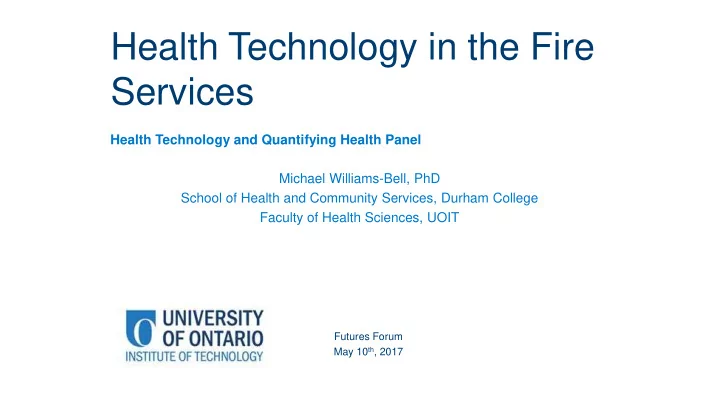

Health Technology in the Fire Services Health Technology and Quantifying Health Panel Michael Williams-Bell, PhD School of Health and Community Services, Durham College Faculty of Health Sciences, UOIT Futures Forum May 10 th , 2017
Engaging the Fire Service in Research • Partnership created in 2005 (TFS) and 2015 (Durham Region) • Ongoing research collaborations to improve on-the-job safety • Develop gaming technologies for assessment and training
What We Know • Previous collaboration with Toronto Fire on studies of Air Management • 1/3 of firefighter injuries are due to contact or exposure to fire with many being preventable by better decision making • Another 1/3 are preventable by improving movement patterns • ACE facility provides a fantastic simulation environment
How can we improve training and reduce the risk of injury?
Serious Games for Training • Serious games are video games used for training • Serious games have been used for cognitive function training under stressful conditions in: – Surgeons (Gallagher et al., 2005) – Military (Cox et al., 2010) • Motor learning principles suggest that training can result in implicit learning by developing skills that are more stable under psychological stress (Mullen, 2007)
Current Research Goals To develop two modules of an interactive serious game to: 1. use posture-tracking technology to provide an effective educational and reinforcement tool for fire fighters to learn correct movement patterns and lifting techniques for specific tasks as test 2. train complex decision making skills required by firefighters in environments that are both physiologically and psychologically stressful.
Background • Specifically, the games would provide a means of measuring and training in a physiologically challenging environment.
Current Research 1: Considering Ergonomics • Partnership with TFS, Durham Region Fire Services, and PSHSA • In the US, 66% of firefighters experience occupational injuries (Hong et al., 2012) – 54% of these injuries are to the back • Obviously, many firefighting activities are unavoidable and safe lifting considerations are not a top priority • Initially, our goal was to better understand tasks and activities performed in the fire hall Lets make fire hall (and truck) tasks safer, so backs are stronger and ready for other activities!
Fire Hall Observations: Tasks in the Fire Hall On the Fire ground
Using Microsoft Kinect for Human Factors Research • Microsoft Kinect TM has the ability to provide real-time anatomical position data in three dimensions (3D) – Assessment – Training
Current Research 2: Decision Making • Under potentially life threatening conditions, firefighters are required to: – Maintain attention – Retain important details (e.g. points of egress) – Cognitive components related to decision making (e.g. recognizing smoke patterns) – Air Management
How does elevated core temperature affect cognitive function in firefighters?
CANTAB Cognitive Function Tests Sustained attention Working memory capacity Visual episodic memory and new learning
How Can We Measure Physiological Demands?
Human Physiological Monitoring Equipment
Heat Stress and Cognitive Function • Conducted in UOIT’s ACE Climate Chamber • 19 firefighters from TFS • Exercise-induced heat Stress on treadmill: – Moderate Intensity: 4.5 km/h at 2.5% grade – Conditions: 1. 30 ◦ C, 50% relative humidity 2. 35 ◦ C, 50% relative humidity
What Did We Find? Visual Episodic Memory 38.5°C * 39.0°C total errors Visuospatial Working Memory spatial * * span length
Development of Serious Game In collaboration with TFS: • Firefighter Task Level Serious Game (FFTL) – Development of a two-storey fire scenario (SME) – Story board created for game developers – Weekly meetings during development – 2 focus groups for SME feedback
FFTL Serious Game
Results: Percent Change in Tasks Completed 10 Percent Change of Correct Responses relative to FFTL 1 (%) 5 0 -5 -10 -15 -20 Following active -25 cooling recovery * -30 FFTL 2 FFTL 3 FFTL 4 FFTL 5 Figure 2: Data from the FFTL revealing the percent change of tasks completed. *indicates different from FFTL 1 (p ≤ 0.05)
Next Steps • Create additional levels of serious game • Varying levels of difficulty • Refine scoring/measurement techniques • Conduct training study
Future Research: Mixed Reality/Immersive Simulation
THANK YOU!
Recommend
More recommend